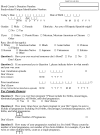The effect of previous pregnancy and transfusion on HLA alloimmunization in blood donors: implications for a transfusion-related acute lung injury risk reduction strategy
- PMID: 19453983
- PMCID: PMC2841001
- DOI: 10.1111/j.1537-2995.2009.02206.x
The effect of previous pregnancy and transfusion on HLA alloimmunization in blood donors: implications for a transfusion-related acute lung injury risk reduction strategy
Abstract
Background: Antibodies to human leukocyte antigens (HLA) in donated blood have been implicated as a cause of transfusion-related acute lung injury (TRALI). A potential measure to reduce the risk of TRALI includes screening plateletpheresis donors for HLA antibodies. The prevalence of HLA antibodies and their relationship to previous transfusion or pregnancy in blood donors was determined.
Study design and methods: A total of 8171 volunteer blood donors were prospectively recruited by six US blood centers from December 2006 to May 2007. Donors provided a detailed history of pregnancy and transfusion and a sample for HLA Class I and II antibody testing by multiantigen bead flow analysis.
Results: A total of 8171 donors were enrolled; 7920 (96.9%) had valid HLA antibody test results and 7841 (99%) of those had complete pregnancy and transfusion information. The prevalence of any HLA antibody was similar in nontransfused (n = 1138) and transfused (n = 895) men, 1.0% versus 1.7% (p = 0.16). HLA antibodies were detected in 17.3% of all female donors (n = 5834) and in 24.4% of those with a history of previous pregnancy (n = 3992). The prevalence of HLA antibodies increased in women with greater numbers of pregnancy: 1.7% (zero), 11.2% (one), 22.5% (two), 27.5% (three), and 32.2% (four or more pregnancies; p < 0.0001).
Conclusion: HLA Class I and Class II antibodies are detectable at low prevalence in male donors regardless of transfusion and in female donors without known immunizing events. The prevalence of HLA antibodies increases significantly with more pregnancies. These data will allow blood centers to estimate the impact of HLA antibody testing as a potential TRALI risk reduction measure.
Figures






Comment in
-
Donor screening as a TRALI risk reduction strategy.Transfusion. 2009 Sep;49(9):1779-82. doi: 10.1111/j.1537-2995.2009.02340.x. Transfusion. 2009. PMID: 19735501 No abstract available.
References
-
- Trial to Reduce Alloimmunization to Platelets Study Group Leukocyte reduction and ultraviolet B irradiation of platelets to prevent alloimmunization and refractoriness to platelet transfusions. N Enl J Med. 1997;337:1861–1869. - PubMed
-
- Cai J, Terasaki P. Human leukocyte antigen antibodies for monitoring transplant patients. Surg Today. 2005;35:605–12. - PubMed
-
- Middelburg RA, van Stein D, Briet E, van der Bom JG. The role of donor antibodies in the pathogenesis of transfusion-related acute lung injury: a systematic review. Transfusion. 2008;48:2167–76. - PubMed
-
- Bux J, Sachs UH. The pathogenesis of transfusion-related-acute-lung injury. (TRALI) Brit J Haematol. 2007;136:788–99. - PubMed
-
- Kleinman S, Caufield T, Chan P, et al. Toward an understanding of transfusion-related acute lung injury: statement of a consensus panel. Transfusion. 2004;44:1774–89. - PubMed
Publication types
MeSH terms
Substances
Grants and funding
- N01 HB047172/HB/NHLBI NIH HHS/United States
- N01 HB047169/HL/NHLBI NIH HHS/United States
- N01 HB047172/HL/NHLBI NIH HHS/United States
- N01 HB047171/HL/NHLBI NIH HHS/United States
- N01 HB047168/HB/NHLBI NIH HHS/United States
- N01 HB047171/HB/NHLBI NIH HHS/United States
- N01 HB047170/HL/NHLBI NIH HHS/United States
- N01 HB047174/HB/NHLBI NIH HHS/United States
- N01 HB047170/HB/NHLBI NIH HHS/United States
- N01 HB047175/HB/NHLBI NIH HHS/United States
- N01 HB047169/HB/NHLBI NIH HHS/United States
- N01 HB047175/HL/NHLBI NIH HHS/United States
- N01 HB057181/HL/NHLBI NIH HHS/United States
- N01 HB047168/HL/NHLBI NIH HHS/United States
- N01 HB047174/HL/NHLBI NIH HHS/United States
LinkOut - more resources
Full Text Sources
Other Literature Sources
Medical
Research Materials

